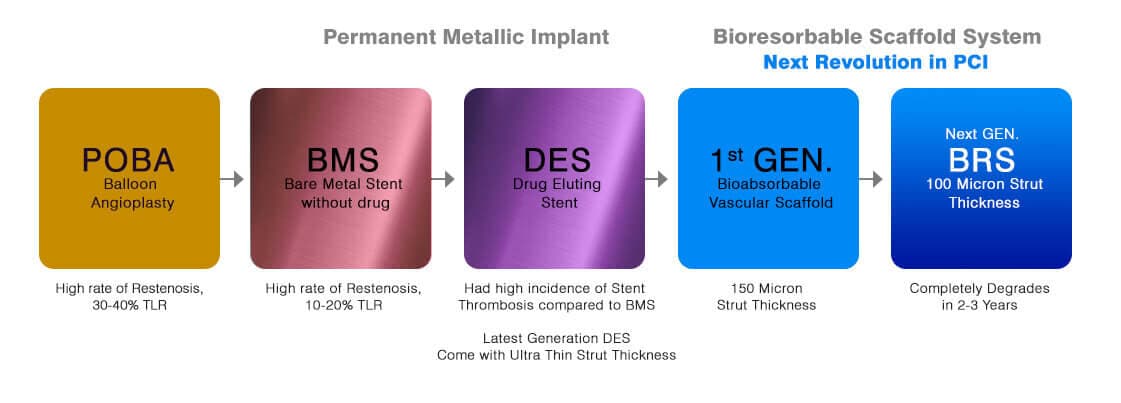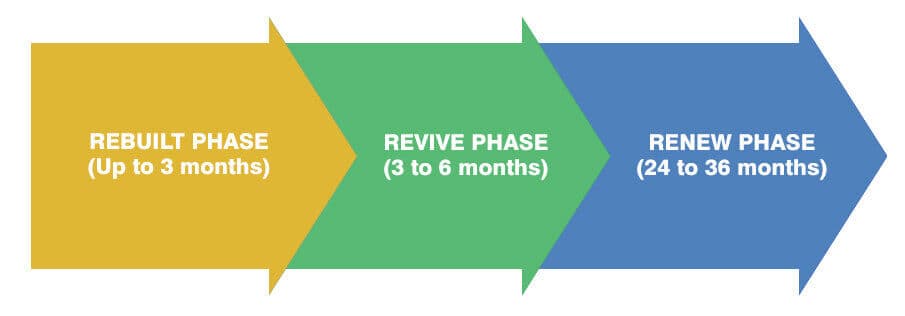Why a Bioresorbable Scaffold ?
The role of a coronary stent implanted during PCI procedure is to provide temporary scaffolding to the blockage or lesion site, as well as to deliver a drug to facilitate healing. Once the lesion has healed, there is no need for the stent to remain inside the body. To offer an analogy, just as paracetamol is not required once a headache passes, or a plaster support is not required once fractured bones heal.
Currently, metallic drug eluting stents remain in the body as a permanent implant. This may not only lead to increased risk of adverse events year on year, but may also pose a hindrance if future procedures need to be performed in the same artery.
BRS provides a temporary scaffold to the lesion to restore the blood flow, once the vessel blockage is treated and healing is completed, BRS dissolves fully, leaving the artery in its natural state with no foreign residue. This provides both physicians and patients the room to explore future treatment interventions, if required, in the same blood vessel.
Evolution of PCI
The field of interventional cardiology has evolved significantly since the first percutaneous coronary angioplasty was performed 40 years ago. This evolution began with a balloon catheter and has progressed into bare-metal stents (BMS), Drug-eluting stents (DES) and culminates with the advent of Bioresorbable stents.
Diagram shown below represents evolution of Percutaneous Coronary Intervention (PCI)

MeRes100™ - Next Gen BRS
MeRes100™ BRS next-generation bioresorbable technology with a low strut thickness of 100 microns which fully resorbs naturally in the artery within 2-3 years, thus restoring the vessel to its true form and nature. The design of MeRes100™ scaffold addresses the limitations of the previous generation scaffold and in a true sense is the next revolution in bioresorbable technology
Phases of Healing with BRS*
Post Scaffold placement body undergoes healing in the following manner

REBUILT PHASE (Up to 3 months)
In this phase the objective is to treat the lesion & restore blood flow. Below are the preferred product characteristics:
- Excellent deliverability with lower crossing profile
- Minimum acute recoil
- Sufficient acute radial strength
- Release of drug in controlled manner
- Excellent conformability
REVIVE PHASE (3 to 6 months)
In this phase BRS resorption occurs by natural process, key features of device in this phase are:
- Excellent strut coverage with functional endothelium
- Gradually lose radial strength
- Become structurally discontinuous
- Allow the vessel to respond naturally to physiologic stimuli
RENEW PHASE (24 to 36 months)
Diagram shown below represents evolution of Percutaneous Coronary Intervention (PCI)
Resorbs in a benign fashion leaving a restored vessel, the artery gets its natural state with no foreign residue except the small platinum markers at scaffold edges remain for future fluoroscopic identification of treated vessel, which provides both physicians and patients with the room to explore future treatment interventions if required in the same blood vessel.
*Individual treatment decision is made by practicing healthcare professional. Each patient is different hence treatment outcomes may differ.
